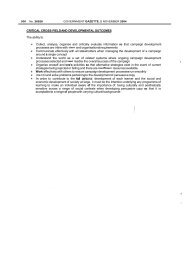The trafficking of children for purposes of sexual exploitation
The trafficking of children for purposes of sexual exploitation
The trafficking of children for purposes of sexual exploitation
Create successful ePaper yourself
Turn your PDF publications into a flip-book with our unique Google optimized e-Paper software.
Eietydse Geskiedenis en Navorsing at the University <strong>of</strong> the Free State was requested to do to a<br />
search <strong>for</strong> newspaper articles <strong>for</strong> the period 1997 - March 2000. Other source material was obtained<br />
through local libraries and resource centres, international and South African Internet search engines<br />
and Molo Songololo's in-house collection <strong>of</strong> materials. Literature was also obtained through<br />
personal correspondence with researchers attached to academic institutions.<br />
4.4. Data analysis and interpretation<br />
4.4.1 Interviews with <strong>children</strong><br />
Interviews <strong>of</strong> <strong>children</strong> were analysed by using an ethnographic analysis. Focusing on the ways<br />
interviewees spoke <strong>of</strong> one another and made sense <strong>of</strong> the events that they experienced allowed <strong>for</strong><br />
the construction <strong>of</strong> a picture <strong>of</strong> meaning <strong>of</strong> relationships to people and the language that people used<br />
to describe each other and the events, which took place.<br />
None <strong>of</strong> the child interviewees spoke English as a first language. However two <strong>of</strong> the 19 <strong>children</strong><br />
preferred to do their interviews in English. <strong>The</strong> remaining 17, interviews were conducted in<br />
Afrikaans. <strong>The</strong> interview with the one young woman was also conducted in Afrikaans. Two<br />
members <strong>of</strong> the research team have not only a pr<strong>of</strong>icient understanding <strong>of</strong> the Afrikaans language,<br />
but also have the necessary cultural understanding <strong>of</strong> words to allow <strong>for</strong> equivalence <strong>of</strong> meaning.<br />
This was particularly important as meanings <strong>of</strong> words can vary or entirely different words may be<br />
employed in referring to the same phenomena.<br />
<strong>The</strong> transcriber also has a pr<strong>of</strong>icient knowledge to allow <strong>for</strong> accuracy in transcription. In addition<br />
field researchers notes were also used to clarify certain aspects <strong>of</strong> interviews. <strong>The</strong> interviews ranged<br />
from 30-minute interviews to 70-minute interviews, with the average length being 45 minutes.<br />
4.4.2. Interviews with organisations and individuals<br />
<strong>The</strong> average length <strong>of</strong> these interviews was 45 minutes. Most <strong>of</strong> these interviews were tape recorded<br />
and transcribed. Field researchers' notes were used as complementary to these transcriptions. <strong>The</strong><br />
purpose <strong>of</strong> these interviews was to obtain in<strong>for</strong>mation about particular aspects <strong>of</strong> relevance to the<br />
research. Most <strong>of</strong> the in<strong>for</strong>mation was <strong>of</strong> a pr<strong>of</strong>essional nature. In these cases a system <strong>of</strong> coding<br />
was used to determine which relevant aspects were being talked about. <strong>The</strong>se were then classified<br />
according to the category <strong>of</strong> data that they belonged to.<br />
4.4.3. Analysis <strong>of</strong> the literature<br />
This comprised three aspects. In the first instance, data was collected from international sources and<br />
from South East Asia in particular. This was done with the purpose <strong>of</strong> identifying key areas <strong>of</strong><br />
research and intervention as well as identifying the conceptual and methodological issues raised by<br />
the material.<br />
In the second instance attempts were made to locate South African research documents on the topic.<br />
In the third instance a survey <strong>of</strong> newspaper articles <strong>for</strong> the period January 1997 - March 2000 was<br />
conducted with the intention <strong>of</strong> establishing what the themes covered by this sector <strong>of</strong> the print<br />
media, are.<br />
This analysis <strong>of</strong> literature allowed <strong>for</strong> the identification <strong>of</strong> phenomena and the definition <strong>of</strong> concepts<br />
to guide the initial phase <strong>of</strong> the research.<br />
4.5. Report writing<br />
<strong>The</strong> report was written to firstly provide in<strong>for</strong>mation and analysis to national, international and<br />
regional organisations with a view to in<strong>for</strong>m social policy and legal re<strong>for</strong>m. It was written secondly<br />
18
















